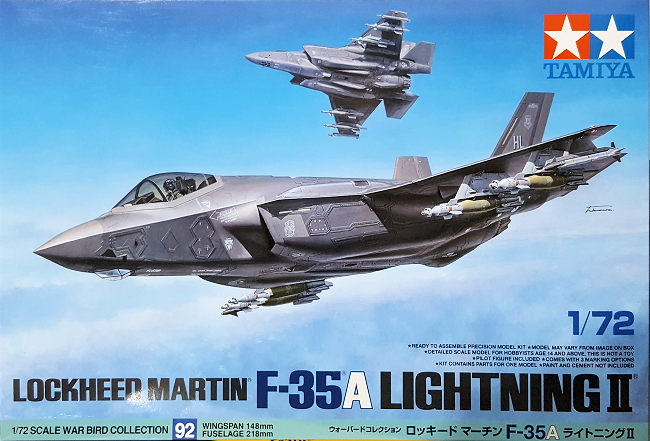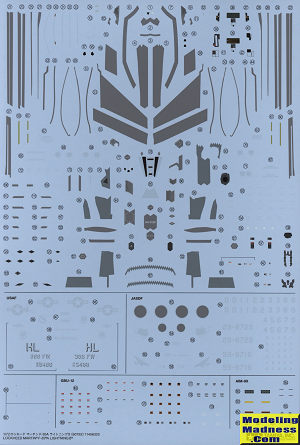
Tamiya 1/72 F-35A Lightning II
| KIT #: | 60792 |
| PRICE: | $30.00 delivered via slow boat from Japan |
| DECALS: | Three options |
| REVIEWER: | Scott Van Aken |
| NOTES: | 2023 release |

| HISTORY |
The Lockheed Martin F-35 Lightning II is an American family of single-seat, single-engine, all-weather stealth multirole combat aircraft that is intended to perform both air superiority and strike missions. It is also able to provide electronic warfare and intelligence, surveillance, and reconnaissance capabilities. Lockheed Martin is the prime F-35 contractor, with principal partners Northrop Grumman and BAE Systems. The aircraft has three main variants: the conventional takeoff and landing (CTOL) F-35A, the short take-off and vertical-landing (STOVL) F-35B, and the carrier-based (CV/CATOBAR) F-35C.
The aircraft descends from the Lockheed Martin X-35, which in 2001 beat the Boeing X-32 to win the Joint Strike Fighter (JSF) program. Its development is principally funded by the United States, with additional funding from program partner countries from the North Atlantic Treaty Organization (NATO) and close U.S. allies, including the United Kingdom, Australia, Canada, Italy, Norway, Denmark, the Netherlands, and formerly Turkey. Several other countries have also ordered, or are considering ordering, the aircraft. The program has drawn criticism for its unprecedented size, complexity, ballooning costs, and delayed deliveries. The acquisition strategy of concurrent production of the aircraft while it was still in development and testing led to expensive design changes and retrofits.
The F-35 first flew in 2006 and entered service with the U.S. Marine Corps F-35B in July 2015, followed by the U.S. Air Force F-35A in August 2016 and the U.S. Navy F-35C in February 2019. The aircraft was first used in combat in 2018 by the Israeli Air Force. The U.S. plans to buy 2,456 F-35s through 2044, which will represent the bulk of the crewed tactical aviation of the U.S. Air Force, Navy, and Marine Corps for several decades; the aircraft is planned to be a cornerstone of NATO and U.S.-allied air power and to operate until 2070.
| THE KIT |
By not being the first to release an F-35, Tamiya was able to produce a kit that represents the current version in production. They also chose the F-35A as that is the type that is currently equipping JASDF squadrons. Tamiya was also smart by providing a kit that can be built in full 'beast' mode, complete with pylons and LGBs.
The kit is split into upper and lower halves with each fuselage half also containing the upper and lower wing. Cockpit is nicely done as you'd expect from Tamiya, and you are provided decals for instruments. If you are installing the wing pylons or the little radar emitters so that airport radars can locate the plane, holes will need to be opened. These latter items would be left off if one is building a combat variant.
The lower fuselage half does not include the nose section, that being separate. One has to build up the main gear wells along with the nose gear well and nose gear before attaching these halves. A neat feature is that the nose gear is hinged so it can be retracted during construction. This allows for a solid attachment later and keeps it from being broken while you are building the rest of the model. The main landing gear and the doors can be attached after the kit is painted. This is also true of the exhaust. Part of the small lower forward fuselage piece includes the intake trunking which terminates in the first compressor stage.
 Flap and
slats are separate, but designed to be posed in the neutral position. Same goes
for the tailplanes and the rudders. One needs to prepaint these items so that
decals can be attached as otherwise some would be impossible to attach. As
mentioned, you get weapons with this one. These included pylon mounted LGBs and
a-a missiles. Interestingly, the last steps are the main instrument panel, seat,
and the canopy. The latter can be posed open or closed as you wish and a pilot
figure is included.
Flap and
slats are separate, but designed to be posed in the neutral position. Same goes
for the tailplanes and the rudders. One needs to prepaint these items so that
decals can be attached as otherwise some would be impossible to attach. As
mentioned, you get weapons with this one. These included pylon mounted LGBs and
a-a missiles. Interestingly, the last steps are the main instrument panel, seat,
and the canopy. The latter can be posed open or closed as you wish and a pilot
figure is included.
Instructions are quite nice with the usual Tamiya paint numbers. Not all the lighter grey is included as decals and for that you'll have to mix colors. If anyone knows the FS of this lighter shade, I'd appreciate that info. Many of the flatter panels are provided decals, but you still have to paint the nose, intake area as well as the leading and trailing edges of the flight surfaces. This mixture is in Tamiya's lacquer range of IJN Grey and NATO Brown. The darker color, which is most of the airframe is also a mixture of a darker IJN Grey and NATO Brown. This shade (whose FS number escapes me at the moment) is fairly easy to find premixed from most paint brands. The decal sheet is quite large for a 1/72 fighter and includes some of the lighter grey panels along with stencils. Markings are for the box art plane from the 388th FW at Hill AFB and for 301 and 302 squadrons JASDF. I'll probably do the Hill plane as the only time I've seen one of these was about 10 years back at a Scott AFB open day.
| CONCLUSIONS |
I'm sure this kit will be quite popular. It is a Tamiya so you know that the engineering will be top rate. I'm not all that fond of most modern jets and have yet to build either an F-22 or F-35, though I have kits in the stash. From what little I've read on this kit, it is a very good one and worth tackling.
| REFERENCES |
https://en.wikipedia.org/wiki/Lockheed_Martin_F-35_Lightning_II
February 2024 Copyright ModelingMadness.com. All rights reserved. No
reproduction in part or in whole without express permssion from the editor. If you would like your product reviewed fairly and fairly quickly, please
contact
the editor or see other details in the
Note to
Contributors.